Christmas & New Year Trading
Website: Open 24/7 for on-line ordering.
Customer Service/Warehouse: Closed 12pm Monday 23rd December 2024, re-opening 8:30am Thursday 2nd January 2025.
All orders placed over the holiday period will be processed in the New Year.
We wish all of our customers a Merry Christmas and a Happy New Year.
10 Most Common Chef Knife Care Mistakes and How to Stop Making Them
Click on the following links to jump to the relevant sections:
- Using steel, ceramic or stone chopping boards
- Using the wrong knife for the wrong task
- Soaking the knife in the sink or washing it with other utensils
- Using the dishwasher
- Storing them in a drawer
- Not honing regularly enough
- Over sharpening
- Leaving the knife on the draining board
- Using the sharpened edge of a knife to scrape food from a chopping board
- Leaving food to dry on the knife
We also offer information on the following:
Dull knives can be dangerous, time consuming and frustrating to use, leading you to squash and tear your ingredients and risking the blade flying off and severing a finger. A sharp, well-honed knife will glide through food, cleanly separating each slice and making any job in the kitchen far easier.
If you find you’re constantly struggling to keep your knives razor sharp then it could be that your day-to-day knife care needs sharpening up.
1. Using steel, ceramic or stone chopping boards
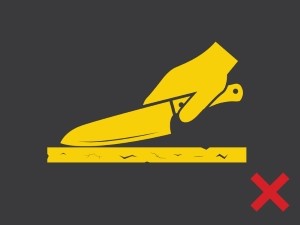 |
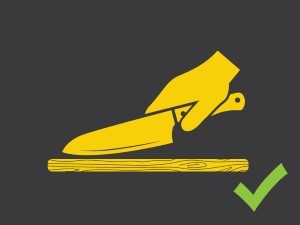 |
Wooden and plastic chopping boards have a little give in them, which is kinder on a knife’s edge; striking a hard surface can dull the blade.
The downside of wooden chopping boards is that they can’t be manufactured in different colours for food hygiene purposes, so are not always suitable for a professional kitchen. Compared to steel, ceramic or stone, plastic chopping boards do have more give in them so are less likely to dull your knives than the harder surfaces.
2. Using the wrong knife for the wrong task
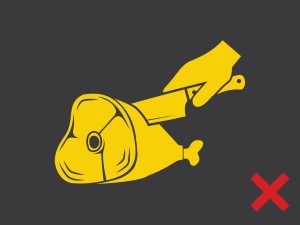 |
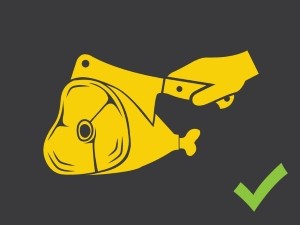 |
Cutting through joints and bones should be done with a boning knife and a cleaver, not a chef’s knife. As tempting as it is to grab the nearest knife available, cutting corners and using the wrong knife for a task is potentially dangerous and is a surefire way to blunt your knives. Using the wrong knife for the wrong task can also damage the food you’re preparing by squashing or tearing it, impairing the texture and presentation. For example, a cleaver is the ideal tool for chopping through large joints of meat as the heavy broad blade will break through bone. After this, you can then use a boning knife for the more detailed work.
3. Soaking the knife in the sink or washing it with other utensils
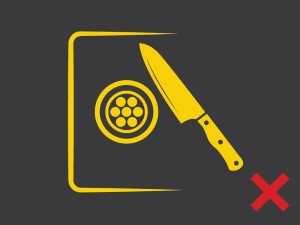 |
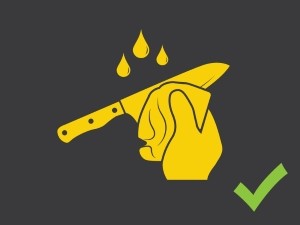 |
Soaking a knife in the sink is an invitation for rust. Even though most knives are made from stainless steel, the stainless element of the blade is a chromium coating which, if soaked often enough, can begin to deteriorate. Once the chromium coating has been compromised the knife is at risk of developing rust. Knives knocking and scraping against other cutlery in a washing up bowl pretty much guarantees dull and damaged edges. Use hot water, soap and a cloth to wash your knives straight after using them.
4. Using the dishwasher
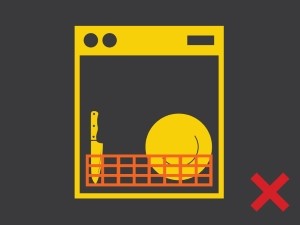 |
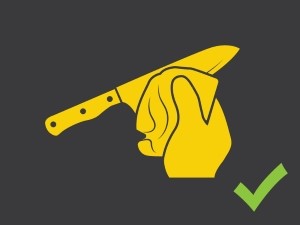 |
High heat, humidity and banging against both other cutlery and the metal shelves of a dishwasher can damage blades. Knives with wooden handles are particularly vulnerable in dishwashers as the force of the water can loosen the handles over time and the high heat can warp the wood, making the knives more dangerous to use.
5. Storing them in a drawer
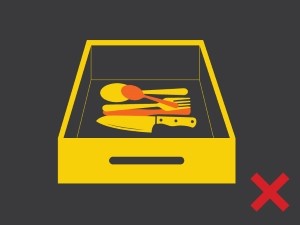 |
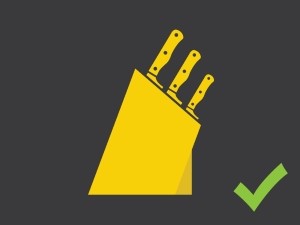 |
Storing sharp knives in a draw with other utensils can mean the blade knocks against other metals, causing damage to the knife. Instead of a drawer, use a magnetic knife rack or a knife block to store your knives safely.
6. Not honing regularly enough
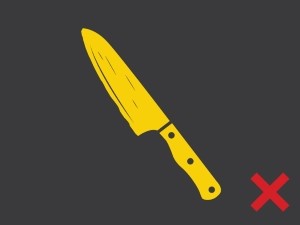 |
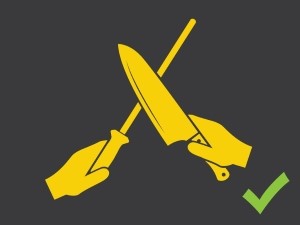 |
Honing a knife with a diamond honer smooths out any nicks in the blade, essentially repairing the metal by aligning the tiny filaments of the blade’s edge. Doing this regularly enough can help prevent the knife from becoming dull.
7. Over sharpening
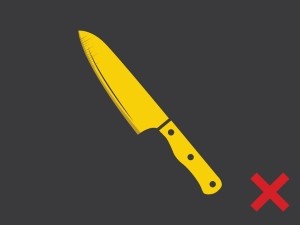 |
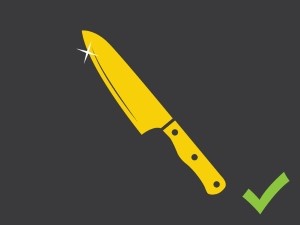 |
Sharpening is a key exercise in maintaining the edge of a blade, but do this too often and you could end up wearing the blade down to the point that it’s unusable. Excessive sharpening can cause the edge of the blade to wear down into the thicker part of the blade, causing the knife edge to become thicker and duller.
8. Leaving the knife on the draining board
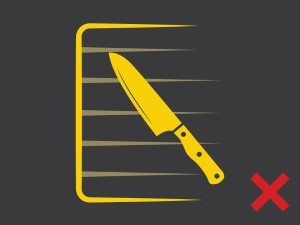 |
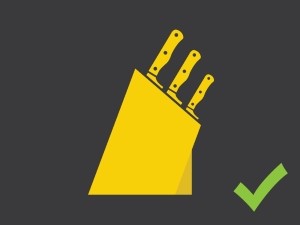 |
Draining boards are a real danger zone for knives as blades can be knocked against other utensils and also left in standing water, running the risk of rusting. Wash and dry your knives straight after using them and store them on a magnetic rack or knife block.
9. Using the sharpened edge of a knife to scrape food from a chopping board
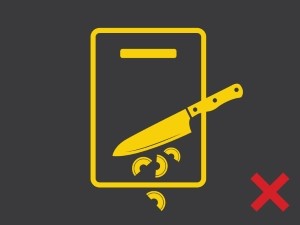 |
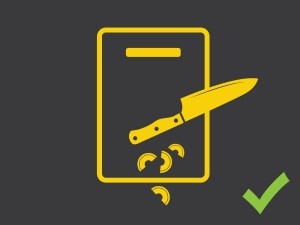 |
Scrapping the sharp edge of a knife against anything is going to dull the blade and scraping it over a chopping board is no exception. Use the spine of the knife to get food from the chopping board to the pan or bowl instead.
10. Leaving food to dry on the knife
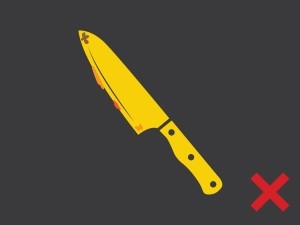 |
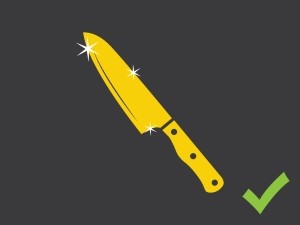 |
If food dries on a knife blade it can be difficult to get off, which can mean having to scrub the food off the blade – a task that’s not only dangerous (one wrong move and you could cut yourself) but which will compromise the sharpness of the blade. Acidic food can also corrode the metal, increasing the risk of rust. Again, wash, dry and store your blade as soon as you’ve finished using it.
Caring for a carbon steel knife
Carbon steel blades are a popular choice for professional chefs; Japanese kitchen knives are traditionally made from carbon steel. Unlike stainless steel, carbon steel can rust if not properly looked after. This is because carbon steel knives do not have the protective chromium coating that comes with stainless steel knives.
The following tips will help to keep your carbon steel knife rust-free and in excellent condition for as long as possible:
- Wipe clean as you cook. For all knives it is important to wash immediately after For carbon steel knives, it is advisable to wipe the blade as you are cooking. This is especially important if you are using ingredients that are acidic, such as fruits, tomatoes and onions. The best way to do this is to take a damp tea towel, fold it neatly into a pad and place it on to your work surface. Then you can simply wipe both sides of the blade on the pad each time you finish cutting.
- Wash and dry before eating. Carbon steel is particularly susceptible to corrosion, so wash with soapy warm water before you sit down to eat your meal. Do not leave you knife covered with food while you eat.
- Hone before use. Keep your blade as sharp as possible by honing with a steel before you begin preparing.
- Remove rusts spots. Rust can develop on carbon steel blades. This should be removed as quickly as possible with water and a brush to prevent it from building up. Sustained rust can damage the metal; removing the rust quickly leaves the blade undamaged.
- Be prepared for ‘patina’ to develop. Patina is the discolouration that can occur when some metals react with oxygen. A common example of this is the greenish/blue hue that forms on copper that is left exposed to the elements. On carbon steel knives, this is usually in the form of a mottled grey appearance on the blade. Unlike rust, this effect is not harmful. While some chefs try to remove the patina for aesthetic reasons, others actively welcome the process, as this layer of oxidisation can work to protect the metal.
Store in a dry place. Kitchens are often humid due to the multiple heat sources and frequent boiling water. To minimise the risk of rusting, store your carbon steel knife away from the kettle, hob or sink. For the best protection, use a wooden knife block or magnetic knife strip.
Knife care oil
Oiling the blades of kitchen knives, especially those made from carbon steel, is an important part of maintenance and will protect against rust and corrosion.
Mineral grade oil is best, though cooking oil can be used. However, cooking oil is not recommended as it can build up and form a sticky residue which is undesirable.
To oil a knife, first:
- Carefully dry the knife — pointing the blade away from you — on both sides.
- Apply mineral oil. This can be done after each use or only every few months.
How to care for a ceramic knife
Care must be taken with ceramic knives. The material most ceramic knives are made from is very hard and can hold an edge for a long time. However, such blades are almost impossible to sharpen yourself and are prone to breaking.
The following tips will help you care for your ceramic knives:
- Always use with a wooden or plastic chopping board as glass or metal boards may chip the blade
- Do not drop on to hard surfaces as this can chip or even snap the blades
- Do not put in a dishwasher
- Do not twist or pry as this may damage the blade
- Be careful when cutting tough food such as hard cheese, squash, turnips etc. as this could lead to undue stress on the blade
- Do not scrape food off chopping boards as this can chip the edge
- Do not apply to an open flame as this may crack the blade
- Store in a wooden knife block
Further Resources
You can find out more about which knives are best for which task by reading the following guides:
If you have any questions about any of the knives we sell at Russums please get in touch on 01709 372345.
29 June 2016





